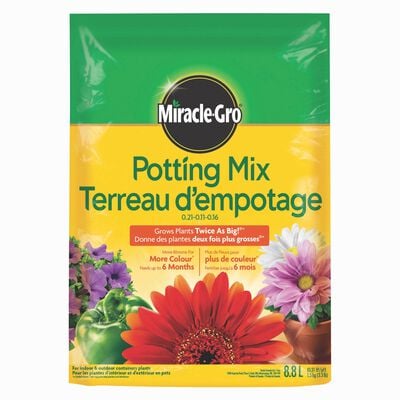
Growing Geraniums
- Before growing geraniums, identify whether you want annual or perennial.
- Plant in spring, well after any chance of frost has passed.
- Plant annuals in full sun (except ivy geranium, which prefers light shade).
- Plant perennials in sun or shade according to the type you have.
- Improve soil nutrition and drainage by adding Miracle-Gro® All Purpose Garden Soil (in-ground), Miracle-Gro® Potting Mix (containers).
- Space appropriately according to plant tags.
- Check soil moisture regularly and water when the top inch is dry.
- Add 2-3 inches of mulch to preserve soil moisture and prevent weeds.
- Feed geraniums regularly with Miracle-Gro® Shake 'N Feed® Ultra Bloom® Plant Food one month after planting.
Want a little carefree beauty in your life? Try planting geraniums. Attractive and easy to care for, geraniums deserve a place in containers, planting beds, and perennial borders.
There are two main groups of geraniums. Annual geraniums (Pelargonium species), which usually only last for a year, include zonal, fancy-leaf, ivy, scented, and Martha Washington (or regal) types. Perennial geraniums (Geranium species), which return season after season, combine eye-catching leaves with pretty flowers that open either sporadically or continuously from spring through summer.
Here is everything you need to know to grow geraniums.
Where to Plant Geraniums
For success with geraniums, you need to know what kind you have so you can choose the best spot for planting. Most annual geraniums need a spot in full sun, except for the ivy geranium, which grows best in light shade. Perennial geraniums, on the other hand, grow in either sun or shade, depending on the type. Both types benefit from protection from sun during the hottest part of the day.
What Kind of Soil to Use for Geraniums
The best soil for both perennial and annual geraniums is one that is both fertile and well-draining. If you're growing geraniums in planting beds, improve soil drainage and quality by mixing 3 inches of Miracle-Gro® All Purpose Garden Soil into the top 6 to 8 inches of native soil. For best results when growing geraniums in containers, fill pots with light and fluffy Miracle-Gro® Potting Mix. When planting geraniums in raised beds, mix equal parts garden soil and potting mix for just the right medium.
How to Plant Geraniums
It's best (and easiest) to start with young plants. Both annual and perennial geraniums thrive in warmth, so wait to plant in spring until after all danger of frost has passed. You can also plant perennial geraniums in the fall, as soon as the summer heat breaks. In regions with mild winters, try planting perennial geraniums from late fall to early spring.
Plant size for geraniums varies by type, with plants growing from 4 to 48 inches tall and 6 to 36 inches wide. Check plant tags to determine the proper spacing for your geranium type. If you're planting geraniums into containers, use a pot that's at least 10 inches across for annual geraniums, or at least 12 inches across for perennial geraniums.
After planting geraniums, water plants well, taking time to soak the root ball and surrounding soil.
How to Water Geraniums
With annual geraniums, check soil weekly, and water when the top inch is dry. Keep newly planted perennial geraniums in consistently moist soil during the first growing season. Once perennial geraniums are established, they can usually survive on rainfall, except during severe drought.
How to Mulch Geraniums
Apply a 2- to 3-inch mulch layer around (but not on) geraniums after planting, to help keep soil moist and suppress weeds by blocking weed growth and access to the sun. Use Scotts® bagged mulch, shredded leaves, pine straw, or some other locally available material.
How to Feed Geraniums
When you start with rich, nutrient-filled soil, your plants get a great starter dose of nutrition. But for best results, you'll also want to feed them regularly throughout the season. A month after planting, apply Miracle-Gro® Shake 'N Feed® Ultra Bloom® Plant Food to give your geraniums the extra boost of nutrients they need for gorgeous blooms. Be sure to follow label instructions.
How to Grow Perennial Geraniums
Perennial geraniums don't need special care to survive winter in even the coldest regions. Cutting perennial geraniums back by roughly one-third after the first flower flush can help spur another round of blooms. If hardy geraniums like 'Rozanne' or 'Pink Penny' spread too far and too fast, simply cut stems back as needed. You can remove as much as two-thirds of the length on these vining geraniums and plants will regrow. After flowering, prune cranesbill geraniums to 2 to 4 inches tall to spur new growth and keep leaves from looking ratty.
How to Use Geraniums
Annual geraniums easily steal the spotlight in containers and planting beds. Ivy geraniums make beautiful hanging baskets, and regal geraniums withstand cool air, making them a logical choice for early spring plantings. Scented geraniums hold their own in containers and make a wonderful patio display, where the fragrant leaves can be touched and savored.
Perennial geraniums bring welcome color to partial shade gardens and can hold their own beneath established trees. Shorter perennial types form flowering ground covers, while mid-size perennial geraniums pair nicely with leggy shrubs.
Ready to start growing geraniums? Click on any of the product links above for more information, to purchase the product online, or to find a retailer near you.


